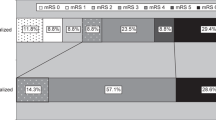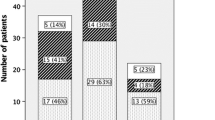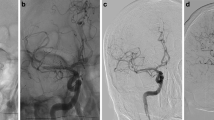Abstract
Purpose
Acute carotid-T occlusion generally responds poorly to thrombolysis. Endovascular mechanical thrombectomy (EMT) seems to be a promising alternative. However, there are few data on EMT in carotid-T occlusions.
Materials and Methods
We reviewed data of 14 consecutive patients with acute carotid-T occlusions treated with mechanical recanalisation devices. A clot separation/aspiration system was used in 11 patients; different other mechanical retriever devices were used in seven patients; and stents were used in four patients. Modified Rankin Scale scores at 90 days were recorded to assess functional outcome.
Results
Six women and eight men were included in the study. Mean patient age was 59.2 years; median National Institute of Health Stroke Scale score on admission was 19; and mean time to treatment was 4.2 h. Successful recanalisation (Thrombolysis in Myocardial Infarction [TIMI] score II and III) was achieved in 11 patients (78.6%). Seven patients (50.0%) were treated with more than one device, leading to successful recanalisation in six of these patients (85.7%). Subarachnoid haemorrhage and large space-occupying bleedings occurred in one (7.1%) and three (21.4%) patients, respectively. At follow-up, three patients (21.4%) were functionally independent, and six (42.9%) had died.
Conclusion
When applying different mechanical devices, we found a high recanalisation rate. However, discrepancy between recanalisation and clinical outcome remained. More data are needed to assess the effect of the different methods on the prognoses of stroke patients.

Similar content being viewed by others
References
Jansen O, von Kummer R, Forsting M, Hacke W, Sartor K (1995) Thrombolytic therapy in acute occlusion of the intracranial internal carotid artery bifurcation. AJNR Am J Neuroradiol 16:1977–1986
Linfante I, Llinas RH, Selim M, Chaves C, Kumar S, Parker RA et al (2002) Clinical and vascular outcome in internal carotid artery versus middle cerebral artery occlusions after intravenous tissue plasminogen activator. Stroke 33:2066–2071
Arnold M, Nedeltchev K, Mattle HP, Loher TJ, Stepper F, Schroth G et al (2003) Intra-arterial thrombolysis in 24 consecutive patients with internal carotid artery T occlusions. J Neurol Neurosurg Psychiatry 74:739–742
Zaidat OO, Suarez JI, Santillan C, Sunshine JL, Tarr RW, Paras VH et al (2002) Response to intra-arterial and combined intravenous and intra-arterial thrombolytic therapy in patients with distal internal carotid artery occlusion. Stroke 33:1821–1826
Eckert B, Kucinski T, Neumaier-Probst E, Fiehler J, Röther J, Zeumer H (2003) Local intra-arterial fibrinolysis in acute hemispheric stroke: effect of occlusion type and fibrinolytic agent on recanalization success and neurological outcome. Cerebrovasc Dis 15:258–263
Jahan R, Duckwiler GR, Kidwell CS, Sayre JW, Gobin YP, Villablanca JP et al (1999) Intraarterial thrombolysis for treatment of acute stroke: experience in 26 patients with long-term follow-up. AJNR Am J Neuroradiol 20:1291–1299
Fiehler J, Knudsen K, Thomalla G, Goebell E, Rosenkranz M, Weiller C et al (2005) Vascular occlusion sites determine differences in lesion growth from early apparent diffusion coefficient lesion to final infarct. AJNR Am J Neuroradiol 26:1056–1061
Saqqur M, Uchino K, Demchuk AM, Molina CA, Garami Z, Calleja S et al (2007) Site of arterial occlusion identified by transcranial Doppler predicts the response to intravenous thrombolysis for stroke. Stroke 38:948–954
Flint AC, Duckwiler GR, Budzik RF, Liebeskind DS, Smith WS (2007) Mechanical thrombectomy of intracranial internal carotid occlusion: pooled results of the MERCI and multi MERCI part I trials. Stroke 38:1274–1280
Lin R, Vora N, Zaidi S, Aleu A, Jankowitz B, Thomas A et al (2009) Mechanical approaches combined with intra-arterial pharmacological therapy are associated with higher recanalization rates than either intervention alone in revascularization of acute carotid terminus occlusion. Stroke 40:2092–2097
Smith WS, Sung G, Saver J, Budzik R, Duckwiler G, Liebeskind DS et al (2008) Mechanical thrombectomy for acute ischemic stroke: final results of the Multi MERCI trial. Stroke 39:1205–1212
Smith WS, Sung G, Starkman S, Saver JL, Kidwell CS, Gobin YP et al (2005) Safety and efficacy of mechanical embolectomy in acute ischemic stroke: results of the MERCI trial. Stroke 36:1432–1438
Penumbra Pivotal Stroke Trial Investigators (2009) The penumbra pivotal stroke trial: safety and effectiveness of a new generation of mechanical devices for clot removal in intracranial large vessel occlusive disease. Stroke 40:2761–2768
Hacke W, Kaste M, Bluhmki E, Brozman M, Dávalos A, Guidetti D et al (2008) Thrombolysis with alteplase 3 to 4.5 hours after acute ischemic stroke. N Engl J Med 359:1317–1329
TIMI Study Group (1985) The thrombolysis in myocardial infarction (TIMI) trial. Phase I findings. N Engl J Med 312:932–936
Hacke W, Kaste M, Fieschi C, Toni D, Lesaffre E, von Kummer R et al (1995) Intravenous thrombolysis with recombinant tissue plasminogen activator for acute hemispheric stroke. The European Cooperative Acute Stroke Study (ECASS). JAMA 274:1017–1025
Yoon W, Seo JJ, Kim JK, Cho KH, Park JG, Kang HK (2004) Contrast enhancement and contrast extravasation on computed tomography after intra-arterial thrombolysis in patients with acute ischemic stroke. Stroke 35:876–881
Rha JH, Saver JL (2007) The impact of recanalization on ischemic stroke outcome: a meta-analysis. Stroke 38:967–973
Schaefer PW, Roccatagliata L, Ledezma C, Hoh B, Schwamm LH, Koroshetz W et al (2006) First-pass quantitative CT perfusion identifies thresholds for salvageable penumbra in acute stroke patients treated with intra-arterial therapy. AJNR Am J Neuroradiol 27:20–25
Wintermark M, Fischbein NJ, Smith WS, Ko NU, Quist M, Dillon WP (2005) Accuracy of dynamic perfusion CT with deconvolution in detecting acute hemispheric stroke. AJNR Am J Neuroradiol 26:104–112
Wintermark M, Reichhart M, Cuisenaire O, Maeder P, Thiran JP, Schnyder P et al (2002) Comparison of admission perfusion computed tomography and qualitative diffusion- and perfusion-weighted magnetic resonance imaging in acute stroke patients. Stroke 33:2025–2031
Wintermark M, Reichhart M, Thiran JP, Maeder P, Chalaron M, Schnyder P et al (2002) Prognostic accuracy of cerebral blood flow measurement by perfusion computed tomography, at the time of emergency room admission, in acute stroke patients. Ann Neurol 51:417–432
Hacke W, Albers G, Al-Rawi Y, Bogousslavsky J, Davalos A, Eliasziw M et al (2005) The Desmoteplase in Acute Ischemic Stroke Trial (DIAS): a phase II MRI-based 9-hour window acute stroke thrombolysis trial with intravenous desmoteplase. Stroke 36:66–73
Khatri P, Wechsler LR, Broderick JP (2007) Intracranial hemorrhage associated with revascularization therapies. Stroke 38:431–440
Berger C, Fiorelli M, Steiner T, Schäbitz WR, Bozzao L, Bluhmki E et al (2001) Hemorrhagic transformation of ischemic brain tissue: asymptomatic or symptomatic? Stroke 32:1330–1335
Fiorelli M, Bastianello S, von Kummer R, del Zoppo GJ, Larrue V, Lesaffre E et al (1999) Hemorrhagic transformation within 36 hours of a cerebral infarct: relationships with early clinical deterioration and 3-month outcome in the European cooperative acute stroke study I (ECASS I) cohort. Stroke 30:2280–2284
IMS Study Investigators (2006) Hemorrhage in the interventional management of stroke study. Stroke 37:847–851
Dabitz R, Triebe S, Leppmeier U, Ochs G, Vorwerk D (2007) Percutaneous recanalization of acute internal carotid artery occlusions in patients with severe stroke. Cardiovasc Intervent Radiol 30:34–41
Eckert B (2009) Acute stroke therapy 1981–2009. Klin Neuroradiol 19:8–19
Conflict of interest
The authors declare that they have no conflict of interest.
Author information
Authors and Affiliations
Corresponding author
Rights and permissions
About this article
Cite this article
Fesl, G., Wiesmann, M., Patzig, M. et al. Endovascular Mechanical Recanalisation of Acute Carotid-T Occlusions: A Single-Center Retrospective Analysis. Cardiovasc Intervent Radiol 34, 280–286 (2011). https://doi.org/10.1007/s00270-010-9980-1
Received:
Accepted:
Published:
Issue Date:
DOI: https://doi.org/10.1007/s00270-010-9980-1




